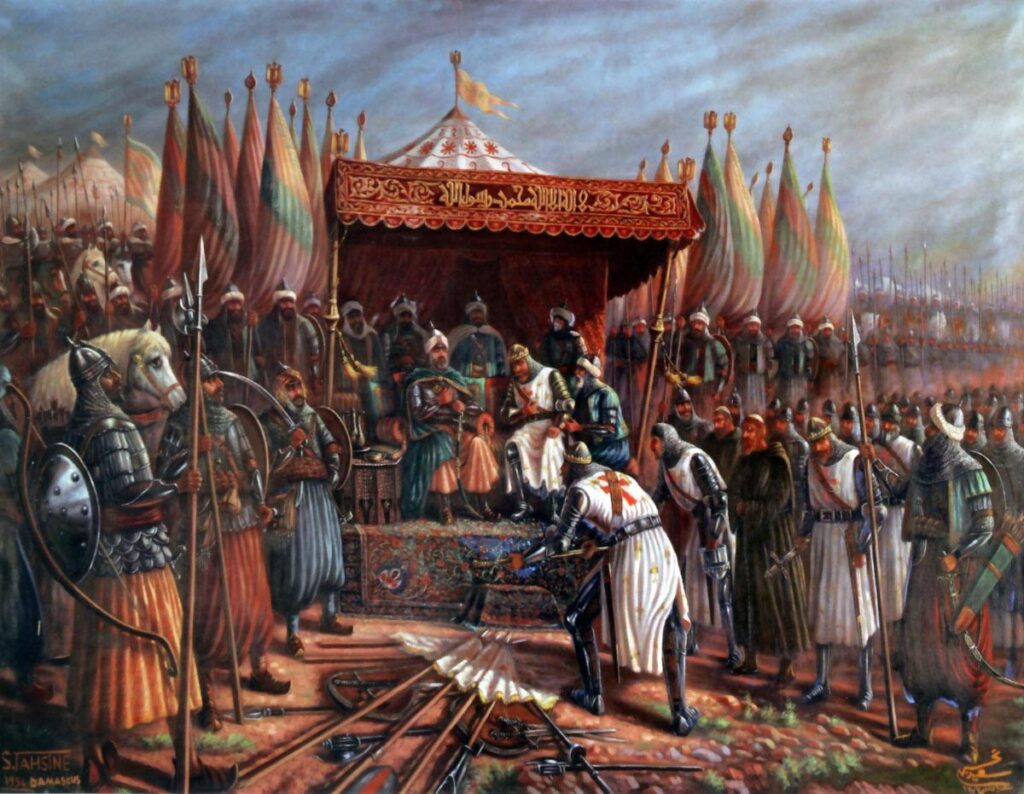A medieval romance becomes a piece of political propaganda
By Misbahuddin Mirza
March/April 2023
King Richard I, popularly known as Richard Coeur de Lion (Richard the Lionheart; 1157-99), was posthumously romanticized for his participation in the ultimately unsuccessful Third Crusade (1189-92) against Saladin (Sultan Salahuddin Ayyubi).
His coat of arms, featuring three lions, was used until 1340 and has survived as part of modern-day coats of arms. Historian William Stubs called Richard “A bad son, a bad husband, a selfish ruler, and a vicious man” (Introduction to the “Itinerarium,” xvii).

Richard I’s life contains a lot of ingredients for a good story: violent rebellions against his father, King Henry II; denying his brother the land his father had bequeathed him; ignoring the Angevin empire’s interests by selling them to raise funds for his massive Crusader armies; slaughtering innocent Muslims; being captured, imprisoned for two years and held for an astronomical ransom; and finally dying by an arrow while personally searching for a petty treasure reportedly buried in a castle.
But does he deserve the title of “Richard the Lionheart”? Or should history remember him as “Richard the Racist Cannibal”?
The Life and Times of Richard I
Richard, the third son of King Henry II of England and Eleanor of Aquitaine, the former wife of King Louis VII of France, was educated in chivalric medieval literature. He composed his own poems in both French and Occitan (a French dialect commonly used in romances). Surprisingly, Richard didn’t speak English and spent only four months of his reign in the country.
These were tense times due to strained relations between England and France, primarily caused by Richard’s family. Louis VII, who wanted to see Henry II’s downfall, began using the 15-year-old Richard as a pawn. His former wife, Eleanor of Aquitaine, was his partner in this effort.
Fifteen years on, Richard again rebelled against his father with the support of Philip II, the new French monarch, and Eleanor. Henry II died shortly after the war. Richard, breaking his promise to his father, refused to give Aquitaine to John, which naturally increased this sibling rivalry.
Pope Gregory VII (1015-85) determined to assert his supremacy over the antipope Clement III, had a plan to make European royalty acknowledge him as their supreme leader: Declare a holy war to retake Christianity’s Holy Land. His successor, Urban II (1035-99), initiated the First Crusade (1095), setting off the most violent bloodletting in medieval history. About a century later, Richard I, Philip II and Emperor Barbarosa responded to Pope Gregory VIII’s call.
In Cyprus, enroute to the Third Crusade (1189-92), Richard humiliated the French monarch Philip II by refusing to marry his sister Alys, who had been betrothed to him earlier, on the grounds that she was Henry II’s mistress. The resulting negative consequences would impact the rest of his life. Richard was fatally shot by a crossbow arrow after besieging a small chateau of Chalus-Chabrol, hoping to unearth a petty treasure reportedly buried in the castle.
Before that, Michael Markowski writes in his “Richard Lionheart: Bad King, Bad Crusader?” (Journal of Medieval History, 1997) that Richard was almost killed during the Third Crusade: “During the restoration of Jaffa … the king personally went foraging, but too far afield with too small a squad (Ambroise, 280-22, “Itinerarium,” 286). Saracens surrounded the group and began to attack. The Lionheart valiantly held off the closing circle of Saracens, but time was running out. From over a hill, one crusader came upon the situation and sized it up. He impersonated Richard in order to lead the attackers to himself, thus making it possible for the king to fight free.”
But Who Was He, Exactly?
Katherine Terrell’s translation of the provocative Middle English romance “Richard Coeur de Lion” (Broadview Press, 2019) offers some interesting information.
• How did “Lionheart” get associated with Richard I? In the poem Richard Coeur de Lion (RCL), during Richard’s captivity, Margery (the German king’s daughter) informs him that she overheard her father’s plans to assassinate him using a lion. Rejecting her advice to escape from prison, he spends the night in hers arms and then wraps his arms in her handkerchiefs. When the lion attacks him, he shoves his hand down its throat and pulls out the lion’s heart.
King Richard thought to himself at that time
What was best to do, and started towards [the lion].
He thrust his arm in at [the lion’s] throat, and
Ripped out the heart with his hand, and
Lungs, and liver, and all he found….
He took the heart, still warm,
And brought it into the hall,
Before the King and all his men.
The King sat at dinner on the dais,
With dukes and earls, proud in the company.
The saltcellar stood on the table.
Richard pressed out all the blood,
And wet the heart in the salt –
The King and all his men looked on –
Without bread he ate the heart…
He may be called, rightly,
The christened king of most renown,
Strong Richard Coeur de Lion! (59-60)
• Richard’s cannibalism. “However, it seems clear that RCL portrays Richard’s cannibalism as a key aspect of his greatness as an English king: the poem transforms this paradigmatic indicator of barbarity into a marker of national distinction” (20).
What, is Saracens’ flesh this good,
And I never knew it until now?
By God’s death and his resurrection,
We shall never die for hunger
While we may, in any assault,
Slay Saracens, take their flesh,
Boil them and roast them and bake them,
And gnaw their flesh to the bones.
Now that I have proved it once,
Before hunger makes me wretched,
I and my folk shall eat more! (21-22)
• The French soldiers’ lack of battlefield courage:
The French men are covetous….
But when they come to a dangerous situation,
And see men begin to deal strokes,
Then they quickly turn tail,
And begin to draw in their horns
Like a snail among the thorns. (129)
Given the above, why do the English try to claim this royal as one of their own? In Chapter 12 of her “Richard Coer de Lyon and Invented Identities,” Lynn Staley comments on the text’s various versions, including the original Auchinleck manuscript: “Its hybrid longevity suggests more than the two-hundred-year appeal of a swashbuckling poem about a king of England who in actuality spent almost no time in his country, devoting himself, instead, to crusading and to Aquitaine, which his mother Eleanor had brought with her when she married Henry II. As Helen Cooper has argued in her learned study of the English romance, while Middle English romance does offer a register of popular tastes, it also offers a register of the ways in which writers employed the motifs of romance to explore issues of contemporary concern over time. The romance is not static, nor are the many versions of a single romance to be discounted as simply evidence of textual corruption. In its versions, a romance may suggest what is topical in one part of England or in one period of time, offering invaluable perspectives upon social or political affinities outside the official chronicler’s scope.”
The synopsis of Katherine Terrell’s translation offers the rest of the answer: “The Middle English romance of Richard Coeur de Lion transforms the historical Richard I of England — a Frenchman by upbringing, who spent only four months of his reign in England and who once joked that he would sell London to finance his Crusade if he could only find a buyer — into an aggressively English king. This act of historical revision involves the invention of several fantastic elements that give Richard the superhuman force necessary to unite the English nation and elevate it above all others. Springing from a supernatural birth and endowed with exceptional strength and an insatiable and transgressive appetite, Richard embodies a vision of triumphant Englishness that humiliates and decimates England’s foes, whether they be French, German, or Muslim.”
The Third Crusade ended with the Holy Land firmly in Salahuddin’s hands, Emperor Barbarosa drowning in a rivulet while enroute, Philip II abandoning the coalition and returning to France and Richard I returning empty-handed only to be captured on the way.
Misbahuddin Mirza, M.S., P.E., is a licensed professional engineer, registered in the States of New York and New Jersey. He served as the Regional Quality Control Engineer for the New York State Department of Transportation’s New York City Region. He is the author of the iBook Illustrated “Muslim Travel Guide to Jerusalem.” He has written for major US and Indian publications.
Tell us what you thought by joining our Facebook community. You can also send comments and story pitches to [email protected]. Islamic Horizons does not publish unsolicited material.
